The Grand Auditorium
Introduction
Text-to-speech Audio
Images
The Grand Auditorium today, with its restored historic neon marquee, a highlight of the forward-looking Art Deco and Streamline Moderne architectural movements, especially evident in American motion picture palaces. (CinemaTreasures user).
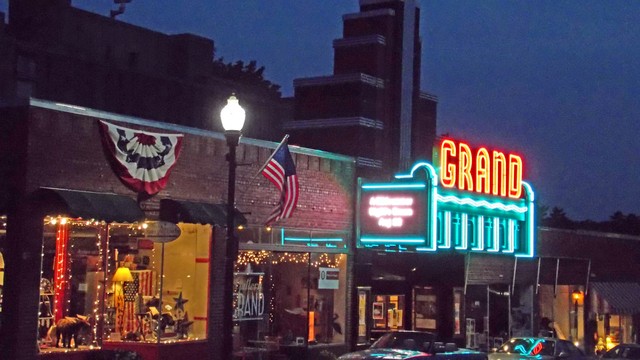
Modern-day interior of the Grand. Not orginally a live theater venue, the Auditorium supports dozens of theater and live music performances a year. (GrandOnline).
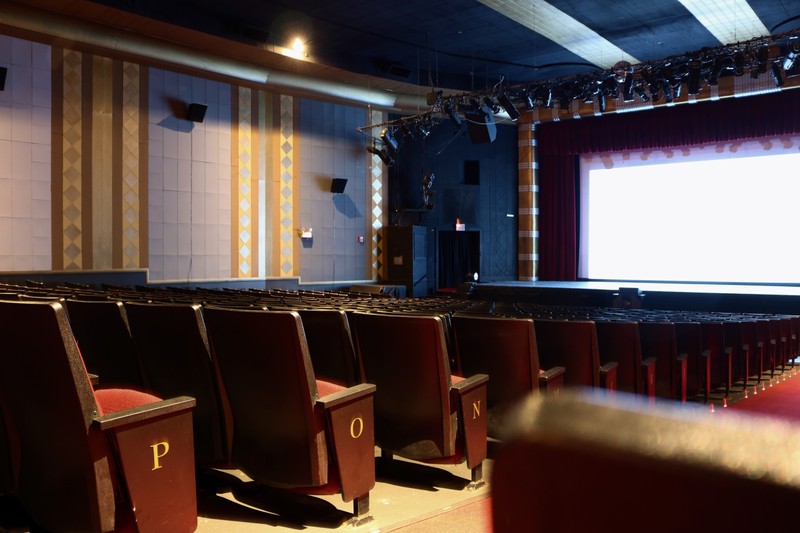
The Great Fire of 1933, which devastated the Ellsworth downtown district. 130 buildings were destroyed by arson. (Ellsworth Public Library).

Destruction on Ellsworth's Main Street from the 1933 fire. Initially a serious blow to the town, it paved the way for Ellsworth's modernization during the reconstruction. (Ellsworth American newspaper).
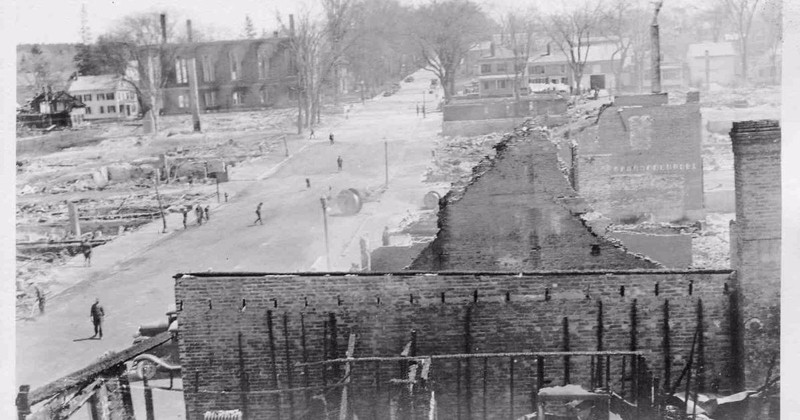
A panorama of the 1933 destruction in Ellsworth. The culprit, a dishwasher at a local restaurant, was later committed to an asylum for the criminally insane. (Ellsworth Historical Society).

The Grand in 1983. Upgrades and restorations have been an ongoing endeavor for decades. New seats were not added until 2006, and the marquee would not be fully restored until 2012. (CinemaTreasures user Betzee).
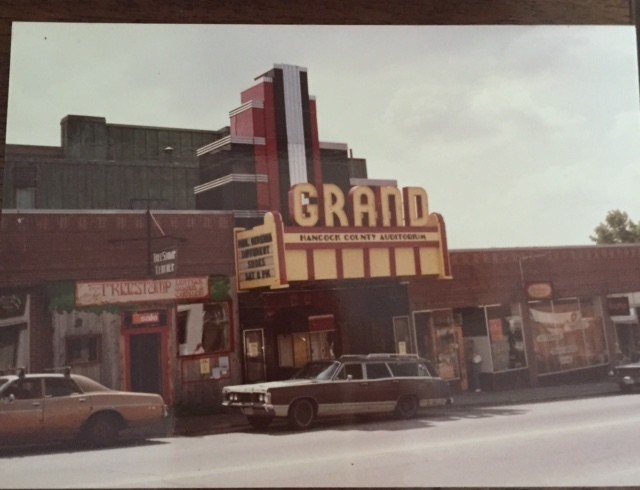
The classic theater retains its original box office structure, a hallmark of early theater designs in America. (CinemaTreasures user Gerald DeLuca).
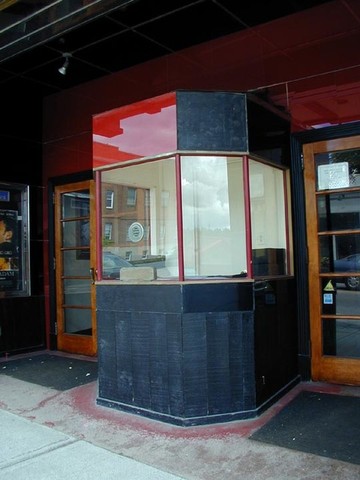
The Grand's roof facade is made of stainless steel and Vitrolite glass, and is considered an "extraordinary example of Art Deco/Modern design," according to the Maine Historic Preservation Commission.
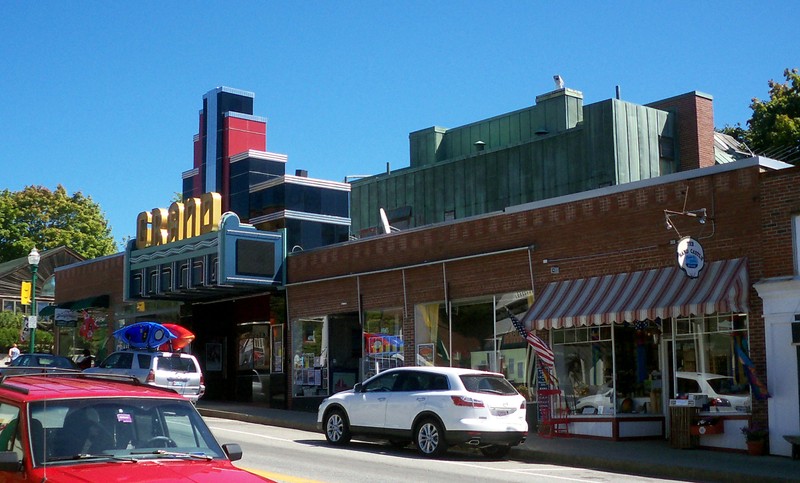
Backstory and Context
Text-to-speech Audio
Hancock County’s seat, the town of Ellsworth, had been a shipbuilding and commercial fishing town in the latter 19th Century, with nearly three hundred vessels licensed in the city in 1872. The last of this industry was swept away in 1923, however, when a great flood along the Union River destroyed the majority of Ellsworth’s docks. Trouble came again a few years later, in the form of the Great Depression, which devastated many of the region’s other industries in 1929.
The nation still squirmed in the grip of a gutted economy when, in 1933, Ellsworth was dealt yet another blow. On May 7, a ravenous fire swept the heart of the city, destroying 130 buildings and laying waste to much of Ellsworth’s commercial districts. It was later determined to be arson and the culprit, Norman Moore (a dishwasher at one of the local restaurants) was committed to an institution for the criminally insane.
Among the many business casualties of the 1933 fire was the Bijou Theater, Ellsworth’s only motion picture venue. As the citizens set about rebuilding their town and replacing the old structures, many of which were vestiges from the previous centuries, Main Street was soon lined with Art Deco motifs, the height of architectural fashion--inspired by a combination of exotic archaeological discoveries in South America and Egypt, and the thrilling technological advances of the Machine Age: modern planes, trains and automobiles adorned with swooping metallic curves made possible by the rapid industrial advances of the last two decades.
The Bijou Theater’s successor, the Grand, was one such building, with a flat, terraced roof reminiscent of a Mesoamerican pyramid and a massive neon marquee (another contemporary technological advancement found frequently in Deco buildings). The architects, Boston firm Krokyn & Browne, are known for designing several iconic theaters of the era in New England. The Grand Theater joined the new chorus of Main Street buildings in 1938, and witnessed the wartime boom that banished the lean Depression years. The theater’s opening was no small event--the entire City Council was in attendance.
Like many theaters, however, its success waned with the arrival of television, and the gaudy picture palace closed its doors in the 1950s. Attempts were made to use the space, including the installation of a boxing ring. No enterprise could keep the theater’s box office in the pink, however, and it seemed doomed to abandonment and demolition by the 1970s.
In 1975, however, a local gallery owner with an interest in community theater noticed the theater in a feature in the local newspaper. Soon a nonprofit was formed, the Hancock County Auditorium Associates, and within a few months had restored the much-damaged facility to working order by replacing broken windows, decrepit wiring and the broken heating system, as well as expanding the stage by twelve feet to make live stage performances more tenable. Much work remained to be done, however, and a benefit performance in August 1975 raised additional funds.
Soon a lineup of additional community theater groups were using the facility as well, and upgrades were made to solidify the Grand’s new presence as a live venue, including a dressing room and upgraded electrical service to accommodate the heavier demands of live theater. 2006 saw new seating added, and today the Grand can accommodate an audience of nearly 400 patrons. Final restorations were made to its iconic Art Deco neon marquee in 2012, when the theater was added to the National Register of Historic Places. Regular performances by a packed slate of community theaters, music groups, and educational programs place the Grand Theater squarely at the heart of Ellsworth’s art scene, and serves as a vibrant reminder of the importance of historic places in community identity.
Sources
A Grand History. Grand Online. Accessed February 03, 2018. http://grandonline.org/about/a-grand-history/.
The Grand Theater. Cinema Treasures. Accessed February 03, 2018. http://cinematreasures.org/theaters/8722.
The Grand, Ellsworth, 1938-1962. Maine Historic Preservation Commission. August 01, 2012. Accessed February 03, 2018. http://www.maine.gov/tools/whatsnew/index.php?topic=mhpc_recent_listings&id=428397&v=article.
